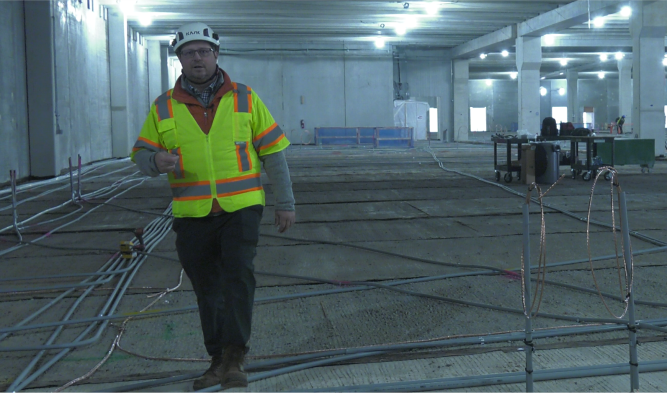4 min read
The Overlooked Priority in Construction Projects: Phasing Security Systems
![]() Theseus Team
:
Jul 14, 2025 9:15:35 AM
Theseus Team
:
Jul 14, 2025 9:15:35 AM

In complex environments like hospitals, government buildings, and large institutional campuses, construction is a constant reality. Whether it's a renovation of a patient wing, the expansion of a government office, or the addition of new departments in a university medical center, these projects often involve highly detailed planning and coordination between architects, mechanical/electrical/plumbing (MEP) engineers, and construction contractors.
But there’s one aspect that too often gets overlooked during planning: security system phasing.
What Is Phasing in Construction?
Phasing refers to breaking down a large construction or renovation project into manageable stages—each with its own schedule, area of focus, and operational impact. For MEP trades, phasing is meticulously planned. Power systems, HVAC, and plumbing are mapped and scheduled down to the hour in many cases. Unfortunately, security systems—including access control, video surveillance, and intrusion detection—are frequently left out of that level of planning.
As a result, critical oversights can occur, leading to avoidable disruptions, increased costs, or worse—gaps in protection.
Why Security Phasing Matters
Security systems aren’t standalone tools—they are infrastructure. Cameras, card readers, intrusion panels, intercoms, and associated network gear are all integrated into the facility’s physical and operational workflows.
When phasing is not properly considered for security, the consequences can be serious. For example:
-
Access control panels feeding an active emergency department (ED) may be located in a wing scheduled for demolition.
-
Video surveillance switches for a pharmacy might be temporarily disconnected because they were overlooked during the construction of a nearby clinic.
-
A government building’s public service counter, which must remain operational for legal reasons, may lose badge access or panic alarm connectivity due to uncoordinated renovation work.
These aren’t hypothetical problems—they’ve happened in real-world projects across both public and private sectors.
Case in Point: A Hospital Renovation
Consider a hospital that’s expanding its intensive care unit (ICU). The new space will include secured access control for staff-only entrances, video monitoring, and intercom systems for visitor assistance.
What many teams forget to consider is how these systems will connect back to the hospital’s main security infrastructure.
In one case, a controller for card readers in the new ICU was scheduled to be located in a room that, during the project’s phasing, was also slated for renovation. The contractor unknowingly removed power and network access to that room—knocking out access control to nearby departments that were still in use.
This happened because security wasn’t involved early enough in the phasing conversation.
Real-World Government Scenario
Let’s shift to a government example. Imagine a county courthouse undergoing a multi-phase security and aesthetic remodel. A phase includes replacing ceilings and lighting in public corridors. However, the surveillance cameras—providing coverage for entry points and hallways—are mounted to those ceilings. If the demolition proceeds without relocating those cameras or provisioning temporary ones, you now have unsecured public areas. This could not only compromise safety but also violate local regulations for courtroom security.
Important Considerations for Proper Security Phasing
When evaluating how to phase a project while keeping security intact, here are several key questions every security manager, project manager, or facility engineer should ask:
-
Where are the head-end devices located?
-
Are any controllers, switches, or servers located in areas scheduled for demolition or renovation?
-
-
Do any active security zones rely on systems within the construction area?
-
Could disconnecting this area impact areas that are supposed to stay secure and operational?
-
-
How will new equipment be connected to active systems?
-
Can we route cabling through corridors that are currently in use?
-
Will the work need to occur after hours or on weekends to avoid disruption?
-
-
What are the operational impacts of downtime?
-
Could this affect patient safety, emergency response, or daily workflow?
-
Are there any compliance requirements or certifications that would be invalidated?
-
-
How will contractors gain access to secured spaces?
-
Are background checks or escorting required?
-
Is there a process for delivering materials without breaching active security zones?
-
The Customer Experience Factor
For healthcare facilities especially, there’s an added layer: patient and visitor experience.
Healthcare executives—especially those in nursing, patient services, and administration—rightly place a high value on the experience of everyone walking through the doors. Construction-related disruptions like visible cabling, drilling, or temporary security outages can negatively impact the sense of safety and professionalism that patients expect.
In government buildings, a similar principle applies to public trust. Citizens expect secure, well-functioning environments when interacting with public services. Anything that feels disorderly, unsecure, or unmonitored can erode confidence.
Why You Need a Security Expert in the Design Phase
This is where professional security consulting—such as the services offered by Theseus Professional Services—becomes essential. Security practitioners must be embedded early in the design and planning process alongside architects, engineers, and construction teams.
Our team frequently steps in to:
-
Map critical security infrastructure and dependencies before demolition or construction begins.
-
Develop security-specific phasing plans that align with construction schedules.
-
Coordinate access control continuity plans and temporary video surveillance deployments.
-
Advise contractors and facility managers on how to move materials securely and minimize operational impact.
Phasing security systems is not just a technical challenge—it’s an operational and reputational concern. It affects safety, compliance, and the public’s confidence in your organization. Whether you're protecting patients, public servants, or sensitive data, planning for security during every phase of a construction project is non-negotiable.
Make sure your next renovation doesn’t just look better—it operates more securely.
Want to learn more about building a resilient security operation?
Watch our free on-demand webinar, “Healthcare Ring of Security,” featuring insights that transcend healthcare and apply to any facility security program. Whether you're managing a hospital or a corporate campus, the strategies discussed can help improve your environment’s safety and operational readiness.
The "Healthcare Ring of Security" webinar is available on-demand, allowing you to watch at your convenience. Don’t miss this opportunity to learn from one of the industry's leading experts and take your healthcare facility’s security to the next level.
To register and access the on-demand webinar, click here >>
 BONUS: DOWNLOAD OUR FREE IN-HOUSE SECURITY RISK ASSESSMENT CONSIDERATIONS GUIDE
BONUS: DOWNLOAD OUR FREE IN-HOUSE SECURITY RISK ASSESSMENT CONSIDERATIONS GUIDE
Security professionals are constantly looking for innovative ways to secure their facility and provide a safe environment within their budget. And, they are also constantly looking for resources to help them achieve that mission while expert advice is hard to come by.
Fortunately, we have released a considerations guide that will help security professionals perform their own in-house security risk assessment.
What's Inside?
This guide is intended to assist you with performing an in-house physical security risk assessment. In many cases, assistance from a third-party expert, like Theseus Professional Services, is required.
Identification of missing or inadequate physical security measures that safeguard assets (people, property, and information) and critical business functions is of paramount importance. The findings of a security risk assessment are used to measure and communicate the level of risk to the organization.
- Process Evaluation
- Threats
- Vulnerability Assessment Highlights
- Electronic Security Systems Considerations
- Site Considerations
- Building Entrances and Exits
- Common Functional Areas
- Building Envelope
- Utilities and Building Services
- Building Systems




